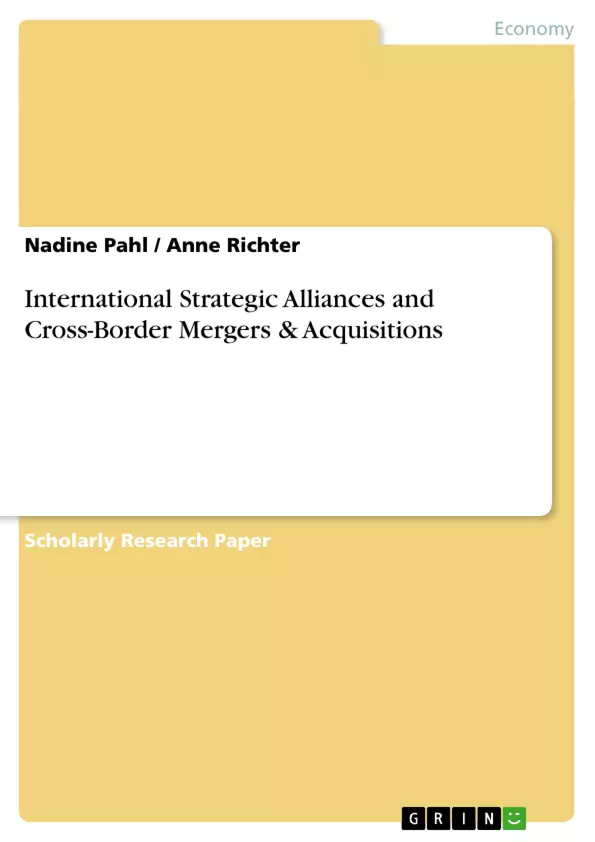Over the past 30 years, there were two main vehicles through which companies have globalised: international strategic alliances and cross-border Mergers & Acquisitions (M&As).
Both vehicles are instruments used by companies to increase their global reach and competitiveness. In the new economy, alliances and M&As seem to be the normal way of doing business. Although strategic alliances and M&As are not a recent phenomena, their pace of growth and the variety of their forms has been increasing.
When dealing with strategic alliances and M&As, four main questions arise:
What are the drivers of strategic alliances and M&As? Which sources of success and failure offer these two growth vehicles? Are there specific determinants that are decisive in the process of establishing a strategic alliance or doing a merger or acquisition? And why do so many M&A fail?
To answer these questions chapter 1 deals with the rationale for strategic alliances and M&As by outlining key points of the past development. Chapter two clarifies the different types of international alliances and their advantages and disadvantages. It also describes success criteria being important for
forming strategic alliances by clarifying the major steps in analysing strategic alliances. To combine theory and praxis, chapter three ends with a short case study about the Renault-Nissan Alliance stating the key success factors. The chapter three is about cross-border M&As by focussing on their the two phases – the pre-acquisition phase and the post-acquisition phase. It describes how companies should decide, give value and negotiate the deal and underlines important managerial processes involved in the integration of the merged company. By analysing the reasons for M&A failures, this chapter underlines the importance of integration for the M&A deal. A short case study of an important acquisition in the banking sector completes chapter 3. Finally chapter 4 summarises the main results.
Inhaltsverzeichnis (Table of Contents)
- Overview
- Introduction
- Why Strategic Alliances Occur
- The Rationale for Mergers & Acquisitions and their Development
- International Strategic Alliances: Characteristics and Assessment Criteria
- Typology of Alliances
- Advantages and Disadvantages of Alliances
- Ways to Make Alliances Work
- Four Steps of Analysing Strategic Alliances
- Framework
- Strategic Context and Value Potential
- Partner Analysis
- Negotiation and Design
- Implementation
- Case Study: Idea and Key Success Factors of the Renault-Nissan Alliance
- Cross-Border Mergers & Acquisitions (M&As) - Key Elements and Risk Factors
- The Difference between Mergers and Acquisitions
- Pros & Cons of M&As
- The Stages of the M&A Process
- Framework for Establishing and Implementing a M&A Strategy
- Pre-Acquisition Phase - The Decision-Making Process
- Post-Acquisition Phase - The Integration Process
- Why M&A Deals do Often Fail
- How Leadership can Make a Difference in the M&A Process
- Case Study: Banking Across Borders - How Santander Wants to Benefit from Acquiring Abbey
- About Santander: Company Profile and Development
- About Abbey - Santander's Latest Acquisition Target
- Assumed Financial Benefits of Santander's Acquisition of Abbey
- Transaction Terms of Santander's Acquisition of Abbey
Zielsetzung und Themenschwerpunkte (Objectives and Key Themes)
This paper aims to provide a comprehensive overview of international strategic alliances and cross-border mergers and acquisitions (M&As). It examines the rationale behind these strategies, explores key characteristics and assessment criteria, and analyzes the successes and failures of various case studies. The paper also delves into the crucial stages involved in the M&A process, highlighting critical risk factors and the role of effective leadership.
- Strategic Alliances: Formation, Advantages, Disadvantages, and Analysis Frameworks
- Mergers & Acquisitions: Processes, Risks, and Success Factors
- Case Studies: Renault-Nissan Alliance and Santander's Acquisition of Abbey
- Comparative Analysis: Contrasting Strategic Alliances and M&As
- Importance of Leadership and Effective Management in Cross-border Deals
Zusammenfassung der Kapitel (Chapter Summaries)
The Overview introduces the concepts of strategic alliances and M&As. The section on International Strategic Alliances details various alliance typologies, their advantages and disadvantages, and provides a framework for analyzing strategic alliances, illustrated with a case study of the Renault-Nissan Alliance. The section on Cross-Border Mergers & Acquisitions covers the differences between mergers and acquisitions, the stages of the M&A process, and common reasons for failure, culminating in a case study of Santander's acquisition of Abbey, examining the company profiles and potential financial benefits.
Schlüsselwörter (Keywords)
International Strategic Alliances, Cross-Border Mergers & Acquisitions (M&As), Alliance Typology, M&A Process, Risk Factors, Case Studies, Renault-Nissan Alliance, Santander Acquisition of Abbey, Strategic Analysis, Leadership, Value Creation, Due Diligence, Integration.
- Arbeit zitieren
- Nadine Pahl (Autor:in), Anne Richter (Autor:in), 2008, International Strategic Alliances and Cross-Border Mergers & Acquisitions, München, GRIN Verlag, https://www.grin.com/document/124619



